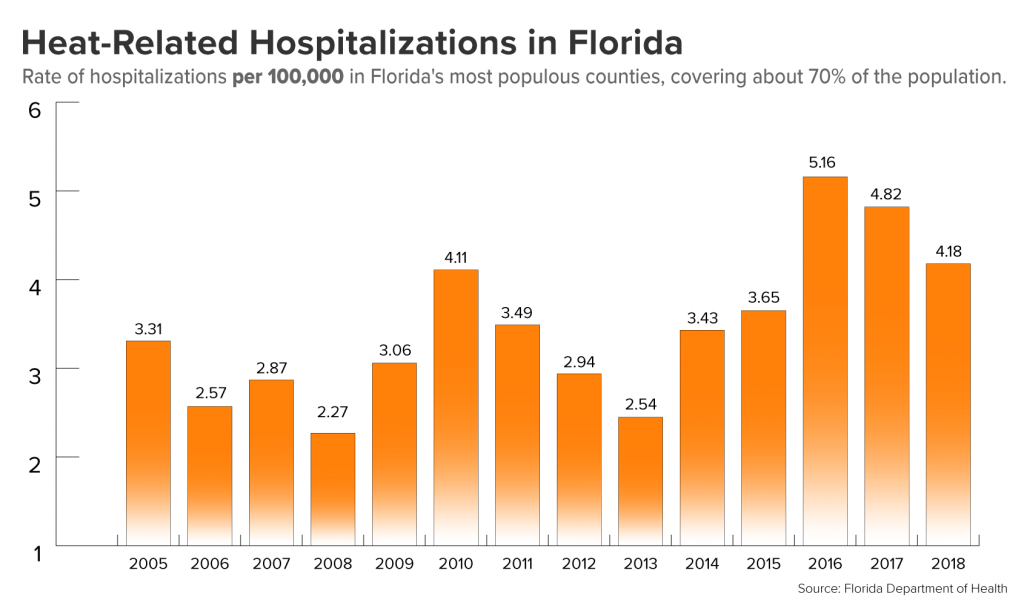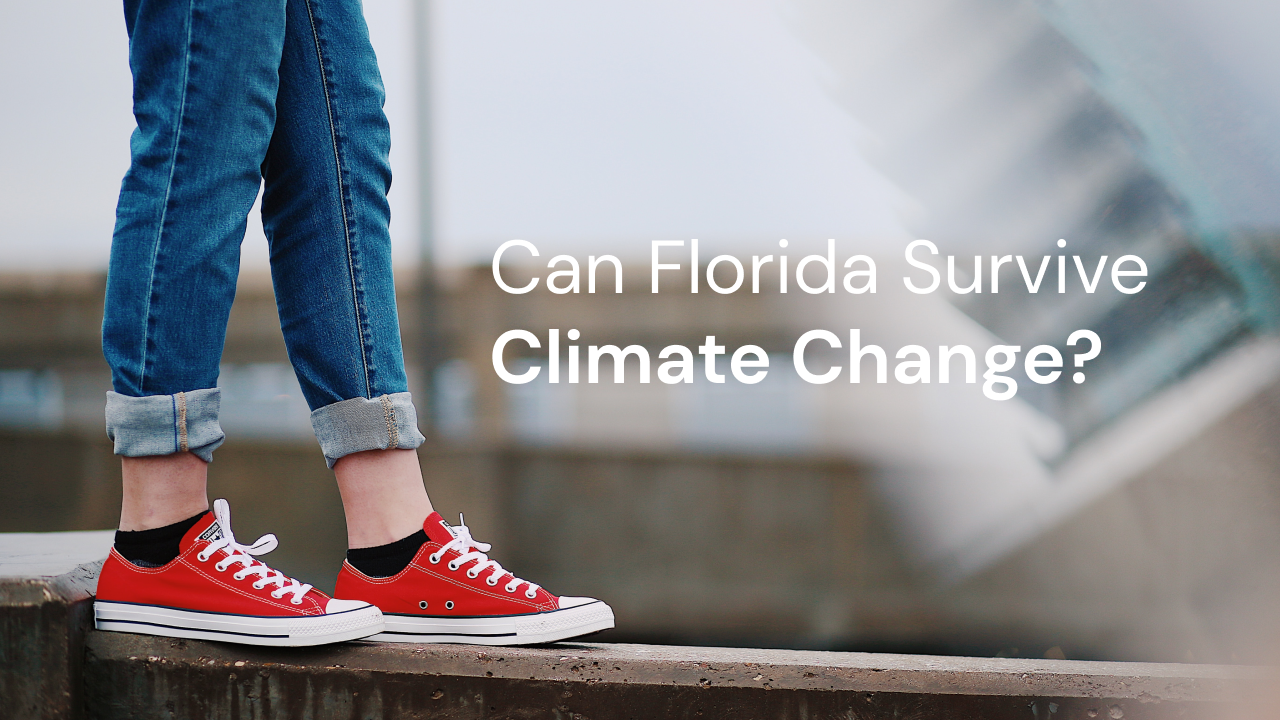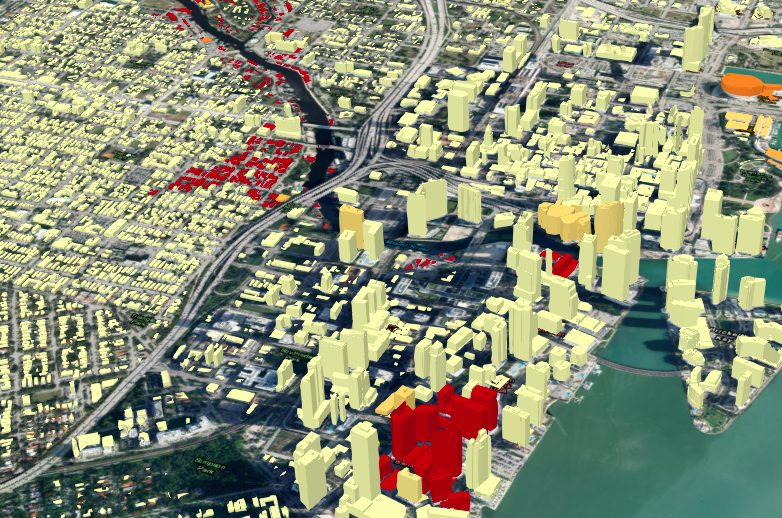Florida is more at-risk from climate change than any other state. The three most significant risks from climate change in Florida are sea-level rise, increased temperatures and more severe storms. Sea-level rise threatens coastal communities due to flooding, storm surges, saltwater intrusion, and septic tank breaches. Rising temperatures, on the other hand, threaten human health directly by increasing the incidence of heat-related illness. Severe storms threaten infrastructure, economy, and human safety.
To determine whether Florida can withstand the effects of climate change on a 50-100 year timeline, we first have to understand what causes climate change and whether it can be slowed. To a great degree, our chances of surviving climate change depend on the actions we take now to stop it.
As renewable energy experts, we know that the transition to green sources of energy like solar are a key part of reducing the threat posed by climate change. But unfortunately, it’s not as simple as just making sure everyone installs solar panels. That’s why I sat down with artist and activist Linda Cheung from Climate Interactive.
Climate Interactive En-ROADS Simulator
Climate Interactive is “an independent, not-for-profit think-tank that grew out of MIT Sloan in Cambridge, Massachusetts, USA. Based on a long tradition of system dynamics modeling, our simulations and insights help people see connections, play out scenarios, and see what works to address climate change, inequity, and related issues like energy, health, and food.”
One of their tools is called the En-ROADS climate simulator. En-ROADS is a free, web-based simulator that allows you to adjust the various levers available to us to stop climate change. Once you have adjusted the parameters to your liking, the simulator predicts the average increase in temperature we can expect in the year 2100. The team has spent many years developing the model and it was made public in late 2019. According to Linda, En-ROADS is “the only global dynamic model that shows you the entire perspective of where global warming will be and what are the major factors that could influence our path to global warming.”
In other words, En-ROADS is basically “the recipe for human survival.” One of the scariest things about climate change is the difficulty in wrapping our heads around how big the problem actually is. According to Linda, this is the only public model available to really help us answer the question of how to create a better world.
The Climate Interactive team organizes in-person sessions with experts to explain En-ROADS, how it works, and how to find the most successful solutions. Here in South Florida, Linda has offered these sessions to hundreds of people. She joined me at home for a special session of En-Roads. Watch the video below:
Using this simulator to model different climate scenarios is the first step to determine whether or not Florida will survive climate change. With no changes, the model predicts we will see an average of 4.2 degrees Celsius of warming by 2100. This would be a disaster scenario and is much higher than the 2 degrees listed as the goal under the Paris climate accord. So, how can we bring it down to keep Florida livable? Linda challenged me to adjust the various levels in the model to try to meet the 2-degree goal.
The Levers We Can Adjust to Stop Climate Change
En-Roads uses 18 different levers in its model. You can see them all, as well as the main categories, in the screenshot below:
As you can see, the main categories of action are Energy Supply, Transport, Buildings and Industry, Growth, Land Emissions, and Carbon Removal. These levers are designed to correspond to actual changes that businesses, governments, and individuals can make. The renewables lever, for example, changes the level of subsidies given to the renewables sector. This subsidy could come in the form of an extension and increase of the investment tax credit, for example.
Each lever interacts with the others. That’s why, when I adjusted the transportation electrification all the way to the right without making any other changes, it had no effect. In addition to electric vehicles, we need low-carbon sources of electricity like solar. So when we move renewables all the way, we can reduce the temperature to 3.7 degrees.
Next, I moved the carbon price lever to disincentive the use of dirty energy sources. With a large carbon price, I brought temperature change down to 2.9 degrees. But what I realized is that the heavily subsidized renewables, high carbon price, and very high incentives for electrification aren’t realistic. I moved them down a little and moved to some of the other levels.
What about carbon removal? Everyone knows that planting trees is good for the planet. So I used afforestation (planting trees), reduced deforestation, and technological carbon capture to see how it would help. Below you can see the combination of levers and the expected effect on global temperature in this scenario.
What I notice now is that it was pretty easy to get down to 3 degrees, but getting down to 2 degrees gets much harder. Linda explains that we are so far into the trajectory toward 2 degrees that we have very few options left to avoid it. In 2020, we are already at 1 degree. Each lever in the model requires ramp-up time to get in place.
Trying to Reach Just 2 Degrees of Warming
After some more tinkering, I taxed coal and subsidized nuclear. Next, I saw what happens with low population and economic growth. Those brought warming down to 2.1 degrees. The big lever I was missing was methane and other greenhouse gas emissions from land use. Methane is a major greenhouse gas that is released by melting permafrost and animal agriculture. In this scenario, I brought it down to 1.8 degrees. Below is some more information about what we can do in Florida to actually help achieve this scenario.
What Florida Has to Do to Limit Global Warming to 2 Degrees
Climate change is a global problem that demands global solutions. This means that the actions taken here in Florida will not be enough to protect Florida from climate change. These actions have to be replicated and scaled around the world. Luckily, there are many communities around the world that have already implemented changes to limit climate change.
There are two approaches we can take to reduce the danger of climate change: implementing top-down solutions (those from governments, businesses and other organizations) and bottom-up solutions (implemented by individuals). Below is a basic list of ideas for each that could be realistically implemented in Florida.
Top-Down Climate Solutions for Florida
The latest top-down climate action plan for the United States was published by the House Select Committee on the Climate Crisis on June 30, 2020. This committee is chaired by Florida’s own Rep. Kathy Castor of Tampa Bay. The core policies advanced by the report include a nationwide renewable energy goal (net-zero by 2050), reform of the flood mapping program, the Green New Deal, carbon capture, zero-emissions requirements for vehicles, incorporation of racial justice programs, emphasis on public health, carbon pricing and carbon removal.
Adding to this list, I have compiled this list of top-down methods to limit climate change:
- Carbon tax
- Cap-and-trade
- Renewable portfolio standards
- Incentives for regenerative agriculture
- Green building standards
- Zero-emissions requirements for vehicles
- Investing in public transit
- Fleet electrification & electric vehicle charging
- Incentives for residential solar
- Creating urban green spaces
- Centralization of heating
- Subsidizing energy efficiency
- Bottle bill
- Investment in virtual power plant technology
- Investment in innovative recycling
Bottom-Up Climate Solutions for Florida
Bottom-up solutions are actions that individuals can take to curb climate change. These revolve around reducing the carbon footprint of your actions. To measure your carbon footprint and get more tips to reduce it, you can use this carbon footprint calculator.
- Avoiding single-use packaging
- Low-impact diets
- Installing solar
- Improving your home’s energy efficiency
- Living walls
- Walking, biking, skating, riding the bus
- Avoiding air travel
- Purchasing an electric vehicle
- Carpooling
- Composting
- Growing food
Tell us in the comments how you are working to reduce your carbon footprint and we’ll add it to our list!
What Will 2 Degrees of Warming Mean for Florida?
So let’s assume we are being optimistic and the world rallies to keep warming to 2 degrees or less. What would this mean for Florida? There are three primary consequences of this level of warming for Florida: sea-level rise, health effects of temperature, and extreme weather events.
Sea-Level Rise in Florida
We can begin to understand what the 2-degree world will look like by examining what the Earth was like during previous periods that were warmer than they are today. In this video, Gray Read and Phil Stoddard give us some of the geological context for understanding the impacts of climate change.
From this video and the study of temperature, sea-level and global temperature over our planet’s history, we learn that atmospheric conditions today are similar to what they were 4-5 million years ago. At that time, sea level was 10-20 meters (33-66 feet) higher than it is today.
Luckily, sea-level rise occurs slowly over time. Even if sea level rise is expected to raise 10-20 meters as a result of climate change, it may not do so for several centuries. The latest predictions from NOAA have sea level on-pace to rise between 0.75 and 6 feet by 2100.
Even a couple of feet of sea-level rise will be devastating for the coastal areas of Florida. In Miami, for instance, the average elevation is only 6.5 feet above sea level. In Jacksonville, it’s 16 feet.
An increase in sea level will cause trouble for Florida for the following two big reasons:
- Increased sea level directly threatens coastal infrastructure such as roads, buildings, and septic systems
- Increased sea level threatens freshwater supplies
Direct Threats to Infrastructure
With such a flat landscape and many connections to the ocean via canals, small increases in Florida’s sea level will cause seawater to extend much further inland. In addition, events such as king tides and storm surges are amplified by small increases in sea level.
Below is an aerial view of buildings around downtown Miami, colored to indicate the risk they would face with 4 feet of sea-level rise.
Red buildings are at extreme risk from 4 feet of sea-level rise in Miami, orange have medium risk, and yellow buildings have low risk. You can see that even relatively far inland, many buildings are still affected by sea-level rise because the rising water is carried by canals inland. Throughout Florida, threats to real estate value total $145 billion. Add to that increased costs of demolition and insurance and sea-level rise shakes out to be a very serious economic threat to Floridians.
You can explore this map yourself under different sea-level conditions in Miami-Dade county.
Threats to Freshwater Supplies
Florida depends on subsurface aquifers for freshwater. This water is set within the porous limestone of Florida’s bedrock. Sea-level rise threatens these aquifers because as ocean water rises, salt makes its way into the limestone, turning freshwater salty. Miami is somewhat unique amongst coastal cities in that building a sea-wall is no protection from seawater intrusion into the land. The ocean water can simply travel under the wall through the porous bedrock and into the aquifer. You can see this depicted graphically on SeaLevelRise.org.
Health Effects of Temperature
The second way that climate change threatens Florida is through the increase in air temperature itself. Florida has already witnessed increased instances of heatstroke and other heat-related illnesses as a result of global warming. This is not surprising given that temperatures in Miami and elsewhere have been shattering records this year.
Follow our friend Brian McNoldy on Twitter for great and almost-daily updates on the state of the weather and climate in Florida. Below is a tweet from July 1 2020 demonstrating the intense heat Miami has experienced so far in 2020:
#Miami #climate and records update…
All-time:
– hottest week ever recorded
– 7 consecutive days with 88°+ daily *average* temperature (old record span for any time of year was 3 days)
(1/3)#FLwx #heatwave pic.twitter.com/bKcqOkm1NO— Brian McNoldy (@BMcNoldy) July 1, 2020
WUFT reported in May 2020 on the rise of heat-related illnesses throughout Florida. As of that time, temperatures in Florida had exceeded the average for 57 out of the last 60 months. You can see the last decade or so of heat-related hospitalizations in the graph below from the Florida Department of Health:
In reality, heat-related illnesses are probably far more common, especially since they disproportionally affect low-income communities that may not have access to medical care. That is because low-income individuals are more likely to have jobs such as landscaping and agriculture that require prolonged time outside.
Extreme Weather Events
The final piece of Florida’s climate future is the effect of climate change on extreme weather events. Currently, the scientific community does not have a consensus on whether or not increased temperatures will lead to more frequent hurricanes or other storms. However, storms are becoming more severe. In addition, the damage caused by storms is compounded by increases in sea level. Higher sea level means storm surges can penetrate further inland. You can see this effect in this segment of Brian’s presentation on Fridays with Daren:
So, Can Florida Survive Climate Change?
Part of the Goldin Solar mission is to preserve a livable Florida for generations to come. It is clear from this analysis that this may be a tall order. Florida is threatened by climate change more than any other state in the US and indeed, more than many countries. Limiting warming to 2 degrees Celsius is feasible, but becomes more difficult every day. Adapting to the realities of increased sea levels, more severe storms, and higher temperatures will test our resilience like never before. To survive climate change, Floridians must take care of one another, spread critical information, and take steps now to prepare for the worst. We can do it. Let’s change the world together.







